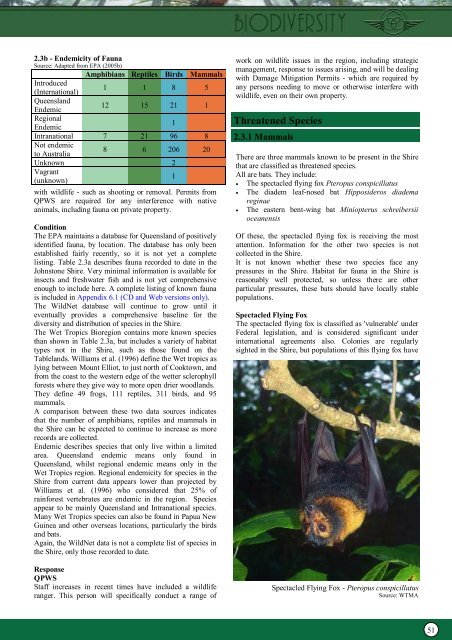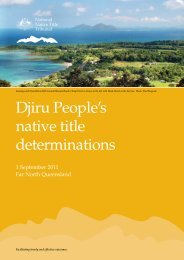Biodiveristy_State of Environment report - Mission Beach Cassowaries
Biodiveristy_State of Environment report - Mission Beach Cassowaries
Biodiveristy_State of Environment report - Mission Beach Cassowaries
- No tags were found...
Create successful ePaper yourself
Turn your PDF publications into a flip-book with our unique Google optimized e-Paper software.
2.3b - Endemicity <strong>of</strong> FaunaSource: Adapted from EPA (2005b)Amphibians Reptiles Birds MammalsIntroduced(International)1 1 8 5QueenslandEndemic12 15 21 1RegionalEndemic1Intranational 7 21 96 8Not endemicto Australia8 6 206 20Unknown 2Vagrant(unknown)1with wildlife - such as shooting or removal. Permits fromQPWS are required for any interference with nativeanimals, including fauna on private property.ConditionThe EPA maintains a database for Queensland <strong>of</strong> positivelyidentified fauna, by location. The database has only beenestablished fairly recently, so it is not yet a completelisting. Table 2.3a describes fauna recorded to date in theJohnstone Shire. Very minimal information is available forinsects and freshwater fish and is not yet comprehensiveenough to include here. A complete listing <strong>of</strong> known faunais included in Appendix 6.1 (CD and Web versions only).The WildNet database will continue to grow until iteventually provides a comprehensive baseline for thediversity and distribution <strong>of</strong> species in the Shire.The Wet Tropics Bioregion contains more known speciesthan shown in Table 2.3a, but includes a variety <strong>of</strong> habitattypes not in the Shire, such as those found on theTablelands. Williams et al. (1996) define the Wet tropics aslying between Mount Elliot, to just north <strong>of</strong> Cooktown, andfrom the coast to the western edge <strong>of</strong> the wetter sclerophyllforests where they give way to more open drier woodlands.They define 49 frogs, 111 reptiles, 311 birds, and 95mammals.A comparison between these two data sources indicatesthat the number <strong>of</strong> amphibians, reptiles and mammals inthe Shire can be expected to continue to increase as morerecords are collected.Endemic describes species that only live within a limitedarea. Queensland endemic means only found inQueensland, whilst regional endemic means only in theWet Tropics region. Regional endemicity for species in theShire from current data appears lower than projected byWilliams et al. (1996) who considered that 25% <strong>of</strong>rainforest vertebrates are endemic in the region. Speciesappear to be mainly Queensland and Intranational species.Many Wet Tropics species can also be found in Papua NewGuinea and other overseas locations, particularly the birdsand bats.Again, the WildNet data is not a complete list <strong>of</strong> species inthe Shire, only those recorded to date.ResponseQPWSStaff increases in recent times have included a wildliferanger. This person will specifically conduct a range <strong>of</strong>work on wildlife issues in the region, including strategicmanagement, response to issues arising, and will be dealingwith Damage Mitigation Permits - which are required byany persons needing to move or otherwise interfere withwildlife, even on their own property.Threatened Species2.3.1 MammalsThere are three mammals known to be present in the Shirethat are classified as threatened species.All are bats. They include:• The spectacled flying fox Pteropus conspicillatus• The diadem leaf-nosed bat Hipposideros diademareginae• The eastern bent-wing bat Miniopterus schreibersiioceanensisOf these, the spectacled flying fox is receiving the mostattention. Information for the other two species is notcollected in the Shire.It is not known whether these two species face anypressures in the Shire. Habitat for fauna in the Shire isreasonably well protected, so unless there are otherparticular pressures, these bats should have locally stablepopulations.Spectacled Flying FoxThe spectacled flying fox is classified as 'vulnerable' underFederal legislation, and is considered significant underinternational agreements also. Colonies are regularlysighted in the Shire, but populations <strong>of</strong> this flying fox haveSpectacled Flying Fox - Pteropus conspicillatusSource: WTMA51



